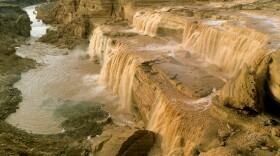At Navajo National Monument up in northeast Arizona, soaring rock alcoves provided shelter for Pueblo people in the thirteenth century. Many alcoves also hold springs, lush with plants. Today on Land Lines, we visit a well-known site, Betatakin--set like a jewel in one of those alcoves.
"The name for this place is Talastima, place of flowers, or corn tasseling. This is where we came from," says Lloyd Masayumptewa, a Hopi and a park archeologist.
People lived here. Their voices and laughter echoed off the great arched ceiling. Over on that balcony, a woman grinds corn, scraping a basalt mano over a conglomerate metate. In the courtyard, a man sits crosslegged, shaping a log with his quartzite hammerstone. A turkey gobbles. Water drips from a spring on the back wall lush with plant life. Juniper smoke curls up and sweetens the air before it wafts out and on down Betatakin Canyon.
This alcove and its canyon are part of the maze of the Tsegi Canyon system, carved into the Shonto Plateau up in northeast Arizona. The walls are Navajo Sandstone, laid down almost two hundred million years ago. Rock made of clean, windborne sand grains cemented with calcite.
A dozen inches of precipitation fall on the Shonto Plateau each year. The moisture readily soaks into this permeable sandstone that serves as a giant underground sponge. The water flows down, meeting the impermeable Kayenta Formation. Then it flows horizontally, emerging as springs along the cliff faces. Ice freezes and thaws, and pries off small slabs. The alcove deepens and widens as whole boulders spall off.
The alcove is immense--370 feet across, a ceiling 450 feet high. Generous enough to hold a hundred and thirty-five rooms that fit perfectly into the natural curved opening. The sloping floor and vaulted ceiling follow crossbeds within the Navajo Sandstone.
The Betatakin alcove faces south and east, offering shade in summer, morning sun in winter, and protection from weather all year. Even with all these benefits, it was the life-giving springs that undoubtedly drew the Ancestral Puebloans to this spot.
"My birth-given name, Hopi name is Piivajouma" says Masayumptewa. "My Anglo name is Lloyd Masayumptewa. I am of the Coyote Clan. This is where a lot of our religious ceremonies were defined and then brought out to Hopi."
Ancestors of the Hopi people lived here. They farmed on terraces at the mouth of the canyon. They went to great effort to build this beautiful stone dwelling. Annual growth rings in the wood beams show that construction started here in A.D. 1250, and ended by 1286. So in less than fifty years, they were gone, probably for a combination of reasons -- unpredictable rainfall? Long-term drought? Fields lost to stream downcutting? Or prophesy to move on? Whatever the reasons, they went south to the Hopi mesas where Lloyd’s family lives today.
Betatakin’s main spring now flows a little less than a gallon a minute. The Southwest has been caught in a period of dryness for a decade, and less moisture has been feeding the sandstone aquifer. The springs--and the hanging gardens--appear to be drying out.
Water carved this canyon and sculpted the alcove. The alcove sheltered Pueblo people.
Rock – water – people. The mandala is no different for us than it was for them. They tried to cope with a long drought in the 1200s, as we cope now. And they knew that everyone lives in this country only with the permission--and the blessing--of the land and sky.







